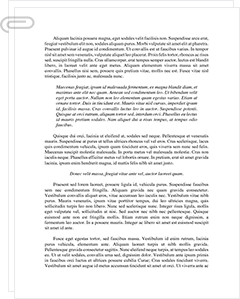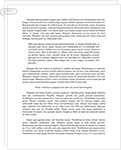 Study Document
Study Document
Art in Non-Western Society the Term Paper
Turtle shell rattles have been used for countless centuries. Such rattles have been recovered from ancient sites in the southwest and in the Mississippian civilizations.
The turtle rattle was also a musical instrument in ceremonial use. One of its most important functions was its significance in the False Face ceremonies. One of the most distinguishing features of the Iroquois belief system is the reliance on the mask for religious and ritual purposes. These masks are often designated as False Faces. This term refers to the first False Face and the mythical origins of protective and healing spirits. They are used in introductory and agricultural rituals. The turtle rattles play a significant part in these important rituals.
In the various curing and healing rituals, the wearer of the False Face will juggle hot coals and use ash and is apparently immune to cold (see below), and he bears a turtle-shell rattle to shake at the person being cured. No Irouk medicine man can do any healing or curing without the rattle and the False Face.
The turtle rattle is therefore integrated with the overall understanding of the origin myths of the Iroquois Indians. The turtle rattle is also seen as a powerful object in its own right and not just a decorative or musical piece. "The turtle is very powerful. The rattle is used to frighten away disease. It is said to be the noise of the Thunders.
4. Bibliography
American Indian Education. http://www.osseo.k12.mn.us/special/stusupport/stuserv/AmInd/LilBuffalo/catalog.htm (Accessed April 30, 2005) www.questia.com/PM.qst?a=o&d=6893078
American Indian Life. Edited by Elsie Clews Parsons. 2nd ed. Lincoln, NE: University of Nebraska Press, 1991. http://www.questia.com/PM.qst?a=o&d=10874442
Fenton, William N., and Gertrude Prokosch Kurath. The Iroquois Eagle Dance: An Offshoot of the Calumet Dance. Washington, DC: United States Government Printing Office, 1953.
NYSM: Lewis Henry Morgan Collection. http://www.nysm.nysed.gov/morgan/display.cfm?catno=36928A. (Accessed April 27, 2005)
http://www.questia.com/PM.qst?a=o&d=7485840
Parker, Arthur C. Seneca Myths and Folk Tales. Lincoln, NE: University of Nebraska Press, 1989. http://www.questia.com/PM.qst?a=o&d=74011670
Radin, Paul. The Story of the American Indian. New York: Liveright Publishing, 1944. http://www.questia.com/PM.qst?a=o&d=21005671
Speck, Frank G., and Alexander General. Midwinter Rites of the Cayuga Long House. Lincoln, NE: University of Nebraska Press, 1995.
THE IROUK CHARACTER. http://www.icculus.org/~msphil/mythus/campaigns/aerth/irouk / (Accessed May 1, 2005) http://www.questia.com/PM.qst?a=o&d=101560010
Tooker, Elisabeth, ed. Native North American Spirituality of the Eastern Woodlands: Sacred Myths, Dreams, Visions, Speeches, Healing Formulas, Rituals, and Ceremonials,. New York: Paulist Press, 1979. http://www.questia.com/PM.qst?a=o&d=5002378936
Vennum, Thomas Jr. "Locating the Seri on the Musical Map of Indian North America." Journal of the Southwest 42, no. 3 (2000): 635. http://www.questia.com/. http://www.questia.com/PM.qst?a=o&d=74095001
Webster, Hutton. Magic: A Sociological Study. New York: Octagon Books, 1973.
A www.questia.com/PM.qst?a=o&d=21005728
Frank G. Speck, and Alexander General, Midwinter Rites of the Cayuga Long House (Lincoln, NE: University of Nebraska Press, 1995), 42.
NYSM: Lewis Henry Morgan Collection. http://www.nysm.nysed.gov/morgan/display.cfm?catno=36928A. (Accessed April 27, 2005)
American Indian Education. http://www.osseo.k12.mn.us/special/stusupport/stuserv/AmInd/LilBuffalo/catalog.htm (Accessed April 30, 2005)
THE IROUK CHARACTER. http://www.icculus.org/~msphil/mythus/campaigns/aerth/irouk / (Accessed May 1, 2005)
Frank G. Speck, and Alexander General, Midwinter Rites of the Cayuga Long House (Lincoln, NE: University of Nebraska Press, 1995), 42.
American Indian Education. http://www.osseo.k12.mn.us/special/stusupport/stuserv/AmInd/LilBuffalo/catalog.htm (Accessed April 30, 2005)
THE IROUK CHARACTER. http://www.icculus.org/~msphil/mythus/campaigns/aerth/irouk / (Accessed May 1, 2005) www.questia.com/PM.qst?a=o&d=21005756
Frank G. Speck, and Alexander General, Midwinter Rites of the Cayuga Long House (Lincoln, NE: University of Nebraska Press, 1995), 70.
Sample Source(s) Used
American Indian Education. http://www.osseo.k12.mn.us/special/stusupport/stuserv/AmInd/LilBuffalo/catalog.htm (Accessed April 30, 2005)
THE IROUK CHARACTER. http://www.icculus.org/~msphil/mythus/campaigns/aerth/irouk / (Accessed May 1, 2005) www.questia.com/PM.qst?a=o&d=21005756
Frank G. Speck, and Alexander General, Midwinter Rites of the Cayuga Long House (Lincoln, NE: University of Nebraska Press, 1995), 70.
Related Documents
 Study Document
Study Document
Museum Displays of "Non-Western" Art Are Qualitatively
Museum Displays of "non-Western" art are qualitatively different from those displaying art that does not come from Europe or North America. Art from places deemed "exotic," or "primitive" tends to be displayed and perceived as anthropological items and indicators of culture. The conceptual arts and "art for art's sake" is frequently denied to non-Western societies. Moreover, the art of places like Oceania is sometimes referred to more as "artifact," versus "art."
 Study Document
Study Document
Responses: Non-Western Monument Art, West African Masks
Art History: Monuments, Masks The temple complex at Angkor Wat in Cambodia is an excellent example of non-western monumental architecture. What is interesting about Angkor Wat specifically is that its motivation for being built was religious, but it survived a change in religious regime: it was built as a Hindu temple complex, but then later repurposed for Buddhism. Consequently Angkor Wat's meaning has become national rather than religion: it is depicted
 Study Document
Study Document
Non-Western Influences on European Art
Art Asia and Africa in Western European Art Globalization is generally associated as a modern phenomenon, however, it is a global movement that began with the Greeks and did not accelerate until the renaissance era. The West, going back to Alexander the Great, has a long history of interactions with Asia and Africa. Ideas and goods were consistently traded. This trend of globalization accelerated with the age of exploration in the 16th
 Study Document
Study Document
Art Culture
Art Culture: Public Space Art Public art like that of Koon's Train (2011), Serra's Tilted Arc (1981), Lin's Vietnam Veterans Memorial (1981), and James' Sea Flower (1978), ignite discussion to the point of its modification, re-arrangement, or removal. The reason for this controversial treatment of public art is its ability to embrace a variety of aesthetic practices. The adoption of different aesthetic values like poster art, outdoor sculpture, earthworks, multimedia projections,
 Study Document
Study Document
Western Civilization Define Its Major
What is usually unconcealed is that much of the machinery and social prototypes which make up what is distinct as modernization were urbanized in the Western worlds. Whether these technical and social prototypes are essentially part of Western civilization is more complicated to respond. Many would dispute that the query cannot be responded by a reply from science and as an alternative is a worth question which should be
 Study Document
Study Document
Art in South America and
This work of art depicts a struggle between two ancestors, the Bungalung man and a Tingari man, the latter of whom was trespassing on sacred land (No author). The copious quantity of dots, particularly the white ones, evinces the full force of the elements invoked by the Bungalung Man to beat his opponent into submission. The power of the Bungalung man is evinced by the fact that he leaves



